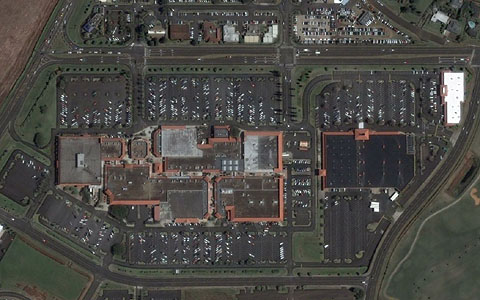by
Juan Wilson on 19 November 2006
Now that Costco has opened it is clear that many on Kauai
feel that Big Box stores are the right thing for our island.
Costco is not the first, but it is the biggest and latest
to be built on Grove Farms land in the Puhi area. In fact,
with the exception of the nearby Walmart, all the Big Box
outlets are in the area centered on the Kukui Grove shopping
mall. It is becoming clear that as this area develops it is
becoming the location that all Kauai residents must go to
to shop.
The Coconut Marketplace was once a place for residents to
shop, but is now focused almost exclusively on the visitor
market. There is of course the strip development between Waipoli
and Kapaa along the Kuhio Highway. The strip offers two major
supermarkets (Foodland and Safeway) and a host of ancillary
business that serve local residents, but it does not have
the Big Box national brands like K-Mart, Sears, Home Depot,
Costco, Macys etc.
The trend towards centralizing the Big Box stores is not likely
to slacken. A critical mass seems to have been reached in
the Kukui Grove Mall area. Now it is the only nationally branded
bookstore, toy store, department store, wholesale outlet,
building material supplier, etc.
The operating philosophy seems to be "if you build it,
they will come". This has added to another growing phenomena
on Kauai - traffic. Of course there are many reasons for traffic
congestion on Kauai. Work, errands, school, and after school
activities are all part of the problem. But certainly, the
centralization of shopping in and around Kukui Grove is increasingly
compounding the problems associated with traffic.
The Big Box stores are dependent on an economy that may be
short lived. That economy requires a housing boom fueled by
cheap oil and supported by continuous growing consumption.
It is my opinion that the hangover from the Bush years will
be an economic depression that will be deepened by ever increasing
energy costs and insurmountable debt that will lay waste to
American consumerism as we know it.
The Big Box explosion in America is a new one. It follows
closely on the development of large tract subdivisions far
away from what were once central cities. Modern suburbia really
got going in 1946, after World War Two. It was driven by relocation
of veterans to new suburbs where there were jobs in aerospace
and other defense industry corporations that were retooling
for the oncoming consumerism that would drive the economy
to this day.
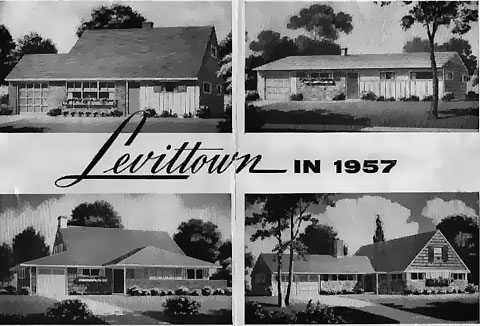
I grew up in one such suburb, Levittown, Long Island, New
York. In about five years ten of thousands of Levitt houses
were built on what had been several thousand acres of potato
fields. The jobs were at Grumman, Fairchild Electric, Republic
Aviation, Sperry-Rand and other defense contractors. At first
there was no place to shop. The plazas and strips had not
yet been built. As a result many entrepreneurs began to service
thousands of new customers. There was daily delivery of milk,
eggs, orange juice and even bacon by the dairy truck. The
bakery truck drove by every home on a daily basis. There were
grocers pulling pushcarts behind their trucks and even knife
sharpeners and shoe repair trucks roaming the street of Levittown.
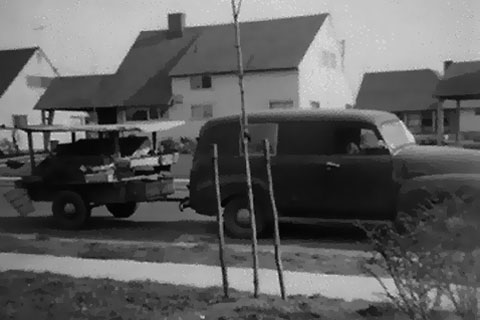
This truck-to-door service lasted a short while after the
supermarkets and plazas started to come in. That is because
almost every household in 1950 was a single car family. Dad
went to work all day while mom took care of the house and
kids.
By the mid 50's that was turning around and most people were
securing a second car. Small plazas anchored by new supermarket
franchises began popping up along what had been country roads.
In 1955, near where I lived the first (and for a long while
the largest) mall in America was built. It was called Roosevelt
Field Shopping Center and was built on a place called Hempstead
Plain. For a while Roosevelt Field drew everybody on Long
Island much like Kukui Grove does on Kauai today.
Roosevelt Field was on Old Country Road. That road was a two
laner with overarching trees in 1950 - today Old Country Road
is six lanes of sprawl.
Since the early 1980's a new and more ominous development
has emerged - exurbia. Exurbia is the residential development
in rural areas beyond the old suburbs and out of touch with
the cities. Exurbia has developed along with office parks
and commercial sprawl often in what was once farmland. Exurbia
s the seed for the Big Box phenomena we see today. In exurbia
most homes require at least two commuting bread winners and
a car for every person of driving age. You have to drive somewhere
to do anything.
Most on
Kauai agree that an exurbia style life is not the direction
we want to see the Garden Island go, yet we embrace the Big
Box stores for their convenience and economy.
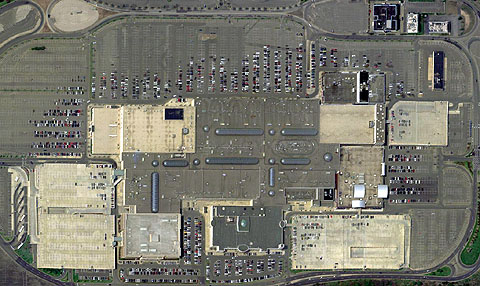
Roosevelt Field Shopping Center on Long Island
as it looks today, was the first mall in America
What is a Big Box Store. Well, California defines big box
retail stores as a “store of greater than 75,000 square
feet". The Maryland Department of Planning defines big
box retail facilities as “large, industrial style buildings
or stores with footprints that generally range from 20,000
to 200,000 square feet”. Like the old malls that needed
the anchor of a Macy's or Sears to support smaller stores,
the Big Box stores attract smaller specialized warehouse type
stores that are big in themselves. These include Staples,
Officemax, Best Buy, Circuit City, Target, Pier One, TJ Max,
and Bed Bath & Beyond, as well as Brand Outlets and more.
The leadership of Kauai, made up of the Mayor and County Council,
are beginning to look past the convenience and economy of
Big Box stores and struggling with what should be done to
control sprawl on Kauai. It has been asked if a limit on square
feet could be put in force to keep Big Box stores from dominating
commerce on Kauai. Should we limit stores to 100,000 or 125,000
square feet?
Well, on Kauai the horse is out of the gate already. We have
four 100,000 square feet plus stores (Walmart, K-Mart, Costco
and Home Depot) in close proximity. Given the range of national
brand chains that cluster around such anchors, any limit above
20,000 square feet will not slow the introduction of second
tier warehouse stores. The average Pier One is about 10,000
square feet; Officemax is about 20,000; Best Buy is about
30,000; Bed Bath & Beyond is about 40,000, and a Target
Store is over 100,000.
As a contrast, the average supermarket in the US is 45,000
square feet, while in the state of Hawaii the average is about
30,000 square feet. On Kauai the average supermarket is even
smaller at about 25,000 square feet. My suggested cap on Big
Box floor area for Kauai would be caped at 25,000 square feet.
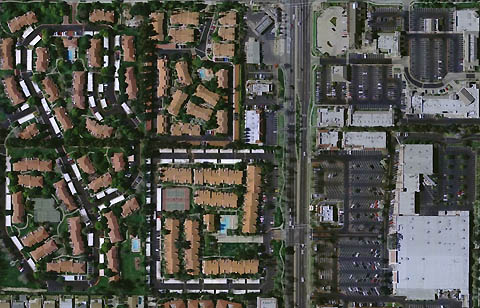
A Big Box Plaza in Rancho Cucamonga, CA,
forty miles east of Los Angeles
The economy of scale that Costco represents is based in part
on the energy and effort required by everyone going to one
source to shop. The two gallons of gas it takes to drive from
Kapaa to Puhi to shop at Costco is part of the cost Costco
doesn't have to pay. I first realized this kind of "false"
savings when buying toys for my kids that were labeled "some
assembly required". It dawned on me that I was working
for Hasbro in a basement assembly sweatshop for no pay.
Another example of a false economy lies in the true cost of
"cheap oil". Cheap oil requires us to have a military
machine that includes several nuclear aircraft carrier groups
and all the personnel and material that supports them. How
cheap is Iraq?
Is there a solution for Kauai residents who need to shop and
their struggle in traffic to do it? Yes, but it won't be very
appetizing until traffic grinds to a halt and gas prices go
through the roof and the economy takes a nose dive.
The answer is in a different distribution model. In some ways
that model already exists in some business operations. We
see it in the distribution of food and goods by Big Save and
Ace Hardware. Instead of having one superstore these businesses
are distributed in smaller stores across the island.
Radio Shack is perhaps a good example. They do not build superstores.
They have a small footprint and could operate several stores
on an island as small as Kauai, if they needed to.
We have in place FedEx, Airborne Express and United Parcel
and even the US Postal Service doing daily deliveries. However,
those same delivery services will be economically useful when
energy costs are so high that one truck distributing locally
sold goods is significantly more economic than each consumer
sending out an SUV to retrieve each order.
Businesses like Costco and Walmart are going to have to reevaluate
their business models to survive the crunch that is coming.
Some will make it, and some won't. Getting "green"
will be a crucial commitment by the survivors. This will include
not only a different distribution model, but a different supply
model. Will a new greener Walmart Superstore have the wisdom
to buy all the Kauai grown organic produce it can get its
hands on, or will it be dependent on Florida and California
for most of its supply? We will see.
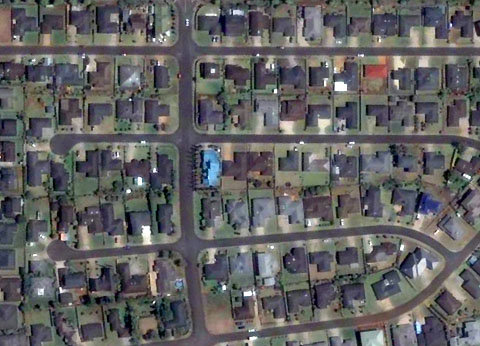
Subdivision in Lihue just south of Kukui Grove
Mall shows advanced stage of Kauaifornication
What will be the effect of the wide adoption of super retail
stores on Kauai? Increasing highway congestion. Too much dependence
on the style of franchise America. It it is embarrassing that
last year Kauai residents voted Walmart as the best source
for flower leis and Starbucks was voted the best cafe on Kauai.
In short, Kauaifornia here we come!
Besides traditional local businesses there will likely be
a niche for new business models that will serve the economic
realities of the future. To anticipate this trend I would
suggest that regional shopping districts be developed in existing
town centers. They would have the effect of de-centralizing
the Big Box monopoly of Puhi and invigorating the outer town
centers.
These regional shopping districts could also be places with
incentives for locating businesses like a Big Save Supermarket,
an Ace Hardware, a Radio Shack, and a Borders Bookstore. I
propose we consider Hanapepe, Koloa, Lihue, Kapaa, and Princeville
as the possible locations for these districts.
In conclusion, our leaders should be imagining what the future
will be like after the "cheap oil" is unavailable
and plan accordingly. In part that means influencing the private
sector to adopt business models that address more than today's
bottom line.
Continuing to build Big Box stores and their ancillary national
brand outlets in one place on the island is only investing
in an easily anticipated economic disaster.
|
